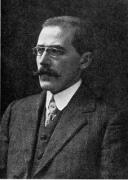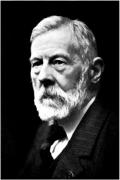|
|
||||||||||||||||||||||||
 |
Featured person
Recently added |
Alfred Stewart (1880 - 1947): |
||||||||||||||||||||||

|
| Alfred Stewart |
Alfred Stewart had what might be seen as a double career. For much of his professional life he occupied a chair in Chemistry at Queen's University, making valued contributions as teacher and researcher; he was also one of the leading authors in his day of detective fiction, at a time when this genre was extremely popular (connoisseurs speak of a "Golden Age"), and his nom de plume, JJ Connington, was well known to the genre's enthusiasts.
Stewart was born in Glasgow where his father was Professor of Divinity and Clerk to the Senate of the University of Glasgow. He was educated at the same university, graduating BSc in 1902 and DSc 1907 (for a thesis on Three Stereochemical Problems); the University of Marburg, Germany, where he studied under Ernst Carl Theodor Zincke, the distinguished chemist after whom the Zincke Reaction and Zincke Nitration are named; and University College London, where supported from 1905 by a Carnegie research fellowship, he carried out doctoral research on the reaction of aliphatic ketones with bisulfite and hydroxylamine; he was also appointed lecturer in stereo-chemistry. In 1909 he was appointed lecturer in organic chemistry at Queen's University, Belfast; between 1914 and 1919 he had a lectureship at Glasgow but returned to Queen's as Professor of Chemistry, occupying this chair until 1944; he was created Professor Emeritus (not an automatic distinction).
His publications within his discipline included Stereochemistry (1907); Recent advances in organic chemistry (1908) which became a successful popular textbook; Chemistry and its borderland (1914); and Some physico-chemical themes (1922). Perhaps his most notable work involved tesla-luminescence spectra: Stewart (working with James Cameron Macmaster and Alfred Russell) by using a fresh method of excitation, obtained a series of spectra each characteristic of the organic compound emitting it. A new constitutional property was thus added to those previously known and a new field in spectroscopy was developed. In addition, in his Recent advances in physical and inorganic chemistry of 1919, he suggested use of the term "isobar" to describe elements which have identical atomic weights but differ in chemical properties. His Recent advances publications formed a kind of series, the last of which appeared in 1944. Besides his research work, Stewart was a highly gifted and popular lecturer and teacher, many of whose students would recall his lectures being as animative as they were informative.
Stewart's parallel career as author was based largely on his detective stories, which he published under the name JJ Connington. Seventeen such works appeared between 1926 and 1947. In 1928 the Times Literary Supplement wrote that he counted in the front rank of detective story writers; his work was praised by Dorothy L Sayers, St John Ervine and John Dickson Carr, three of the most prominent writers in the genre. Carr, in a widely-read essay on contemporary detective fiction, "The Grandest Game in the World", paid tribute to Stewart/Connington's "sheer brain power". Like many or most successful writers of crime and detective fiction, he created memorable characters, in Stewart's case, Superintendent Ross and Chief Constable Sir Clinton Driffield. His first published novel however was a science fiction "eco-catastrophe" (a modern term), Nordenholt's Million, which appeared in 1923 and in which world agriculture is attacked by denitrifying plant bacteria; the title refers to a ruthless plutocrat who constructs a survivalist colony in England, and works to sabotage the surrounding socio-political fabric, becoming more and more oppressively totalitarian towards his colony's million-strong population, who, even after the ecological peril subsides, despoil what social cohesion as pertained in what some commentators saw as a Stalinesque collective farm (which would seemingly ascribe to Stewart some prescience). Stewart had an almost-contemporary and namesake at Queen's, John Innes Mackintosh Stewart, lecturer in English Literature (1945-1949) who also published detective fiction under a pseudonym.
Stewart suffered health problems later in his life, and his decease occurred one morning, busy at his latest writing work, at his home at 83 Balmoral Avenue, in south Belfast (the modern-day "Queen's Quarter").
| Born: | 5 September 1880 |
| Died: | 1 July 1947 |
| Richard Froggatt |
| Bibliography: TW Moody & JC Beckett: Queen’s Belfast 1845-1949: The History of a University; Brian Walker & Alf McCreary: Degrees of Excellence: The Story of Queen’s Belfast 1845-1995, (Belfast, Institute of Irish Studies, 1994); Oxford Dictionary of National Biography; Nature 158, 613-613 (02 November 1946); www.gadetection.pbworks.com; www.mikegrost.com/allingh |


Home | Our Policies | Plaques | Browse | Search | Sponsors | Links | Help | Contact
Privacy & Disclaimer | Cookie Policy | Site Map | Website Design By K-Point
© 2024 Ulster History Circle









